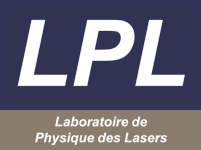High-Sensitivity Microwave Spectroscopy for Precision Measurements and Tests of Fundamental Physics
Post: Master internship in Experimental Molecular Physics
Location: Laboratoire de Physique des Lasers (LPL), CNRS-Univ Sorbonne Paris Nord, Villetaneuse, France
Team: Metrology, Molecules and Fundamental Tests (MMFT)
Advisors: Dr Benoît Darquié, Dr Raphaël Hahn, Dr Mathieu Manceau
Contract: Fixed Term, 4-6 months, starting in Spring 2026
Internship description:
The master student will join the effort at LPL to develop a new-generation compact and versatile microwave (MW) spectrometer operating over the 2–20 GHz range. This instrument is conceived both as a high-sensitivity detector of internal quantum states in polyatomic molecules and as a precision tool for molecular frequency metrology. Proof-of-principle measurements have already demonstrated free induction decay (FID) signals on the J = 0 → 1 rotational transition of OCS at 12.163 GHz with outstanding signal-to-noise ratios. The MW spectrometer is now
being pushed towards unprecedented performance: thanks to SI-traceable and ultrastable frequency references disseminated by the REFIMEVE network, the goal is to pinpoint MW rotational lines of molecules at the sub-Hz level, enabling stringent tests of molecular models and fundamental physics.
In particular, the spectrometer will enable cross-checks between MW rotational frequencies and mid-infrared (MIR) rovibrational data planned to be measured at the 100 Hz level in the frame of the ANR Ultiμos project. These comparisons are directly motivated by the search for potential variations of the proton-to-electron mass ratio μ, a fundamental constant whose stability can be tested by confronting laboratory data with MW astronomical spectra of molecules such as methanol and ammonia. These species possess transitions with strong sensitivity coefficients to μ, making them powerful probes of possible temporal or spatial variations of fundamental constants. In Ultiμos, spectroscopy with ultrastable MIR quantum cascade lasers provide ultra-precise MIR frequencies with relative uncertainties of 10 ¹². By using combination–difference schemes, ⁻ these MIR data yield effective MW intervals that can be directly confronted with our SI-traceable MW measurements. Such dual determinations, based on entirely different experimental chains and affected by distinct systematic effects, are ideal for robust cross-validation of frequency values and uncertainty budgets.
The student will participate in further developments aiming at:
- Characterizing and optimizing the MW spectrometer performance waveguide configuration.
- Preparing for a MW cavity configuration.
- Performing precision spectroscopy of benchmark molecules (OCS, methanol, ammonia).
- Preparing for double-resonance MIR–MW schemes to improve SNR in rovibrational spectroscopy.
- Preparing for integration with a cryogenic buffer-gas cooling source of cold molecules at ~3 K.
The internship will thus combine experimental molecular spectroscopy, frequency metrology, fundamental physics and advanced detection methods.
Keywords: Microwave spectroscopy, free induction decay, double resonance MIR–MW, frequency metrology, cryogenic buffer gas cooling, precision measurements, optics, electronics, programming & simulation
Relevant publications from the team: Tran et al, APL Photonics 9, 3, (2024);Fiechter et al, J Phys Chem Lett 13, 42 (2022); Cournol et al, Quantum Electron. 49, 288 (2019), arXiv:1912.06054; Tokunaga et al, New J. Phys. 19, 053006 (2017), arXiv:1607.08741.
Requirements: The applicant should be doing its master studies in a relevant area of experimental physics or chemical physics: atomic, molecular and optical physics, spectroscopy, lasers, quantum optics. Interested applicants should email a CV, a brief description of research interests and the contact details of 2 referents M.Manceau.
There is a possibility of pursuing a PhD within the project, with funding already secured.
You will find the job description here
